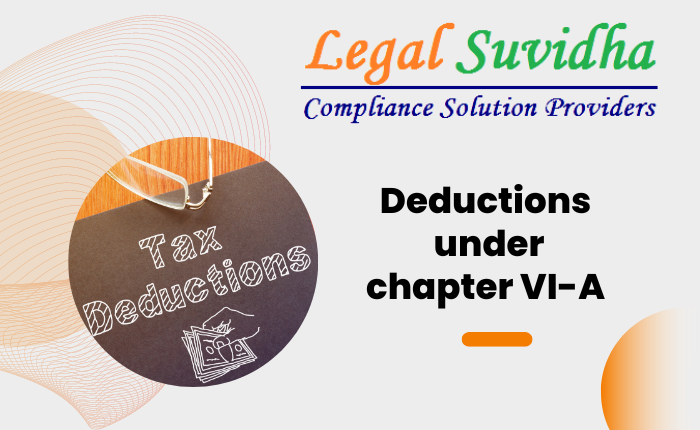Taxation can often feel like navigating a maze of complex rules and regulations. Among the many aspects of taxation, the Income Tax Act holds particular importance for individuals and businesses alike. It outlines various deductions under Chapter VI-A available to taxpayers, aimed at reducing their taxable income and ultimately, their tax liability. However, the intricacies of deductions can be puzzling. In this blog, we will embark on a journey to demystify these intricacies and shed light on how taxpayers can effectively leverage these deductions.
Understanding Chapter VI-A: The Basics
Income Tax Act, 1961, is a treasure trove of deductions under Chapter VI-A that taxpayers can claim to lower their taxable income. This chapter comprises multiple sections, each catering to different types of taxpayers and expenses. These deductions are designed to incentivize various investments, expenditures, and contributions that contribute to the overall growth of the economy.
Navigating the Deduction Categories
These deductions are broadly categorized into sections such as 80C, 80D, 80G, 80E, 80TTA, and more. Each section corresponds to a particular type of expenditure or investment, and each has its own set of rules and limits. Let’s explore some of these sections in more detail:
1. Section 80C: This is perhaps the most well-known section. It covers deductions under Chapter VI-A for investments made in various financial instruments, including the Public Provident Fund (PPF), Employees’ Provident Fund (EPF), National Savings Certificate (NSC), tax-saving fixed deposits, and more. Taxpayers can claim deductions up to a certain limit, which may change from year to year.
2. Section 80D: This section focuses on deductions under Chapter VI-A related to medical insurance premiums paid by individuals for themselves and their families. It’s crucial to understand the limits for different categories of taxpayers and the distinction between individual, family, and senior citizen policies.
3. Section 80G: This section encourages charitable donations by allowing taxpayers to claim deductions under Chapter VI-A on donations made to specified funds and charitable organizations. However, not all donations are eligible for deductions, and it’s essential to ensure that the recipient is eligible under this section.
4. Section 80E: This section provides deductions under Chapter VI-A for interest paid on education loans. It’s a boon for individuals pursuing higher education or funding their children’s education, as it eases the financial burden by lowering the effective cost of borrowing.
5. Section 80TTA: This section pertains to deductions on interest income from savings accounts. Taxpayers can claim deductions under Chapter VI-A on interest earned from savings accounts up to a certain limit. It’s a small but significant benefit, especially for those who maintain substantial balances in their savings accounts.
Complexities and Common Misconceptions
Despite the potential benefits, taxpayers often struggle with the complexities associated with these deductions under Chapter VI-A. Some common misconceptions include:
1. Assuming All Investments Qualify: Not all investments or expenses automatically qualify for deductions under Chapter VI-A. Each section has specific criteria that must be met, and taxpayers should be cautious about assuming blanket eligibility.
2. Overlooking Carry Forward Rules: Some deductions come with the advantage of carry-forward. For instance, if your eligible deductions exceed your taxable income in a given year, you can carry forward the unused portion to subsequent years. This provision can be especially beneficial for certain deductions.
3. Missing Deadlines: Many deductions require taxpayers to make investments or expenditures within a specified timeframe. Failing to meet these deadlines can lead to missed opportunities for deductions under Chapter VI-A.
Seeking Professional Guidance
Given the intricate nature of deductions, seeking professional guidance is highly recommended. Tax consultants or financial advisors can provide personalized advice based on your financial situation, ensuring you make the most of available deductions under Chapter VI-A while staying compliant with the law.
In Conclusion
Deductions offer a valuable avenue for taxpayers to reduce their tax liability while contributing to their financial well-being and the overall development of the country. By understanding the various sections, their eligibility criteria, and the limits associated with them, taxpayers can navigate the complexities with confidence. Remember, staying informed and seeking expert advice can go a long way in optimizing your tax planning strategy and making the most of these deductions under Chapter VI-A.
If You have any queries then connect with us at [email protected] or [email protected] & Contact us & stay updated with our latest blogs & articles


![Received an Income Tax Notice in India? Don’t Panic — Here’s Exactly What to Do [2025 Guide] 1 Income Tax Notice](https://legalsuvidha.com/wp-content/uploads/2025/12/Income-Tax-Notice.png)
![Cyber Crime FIR in India: How to File Complaint for Online Fraud, Banking Fraud & Digital Harassment [2025 Guide] 2 Cyber Crime Complaint](https://legalsuvidha.com/wp-content/uploads/2025/12/Cyber-Crime-Complaint.png)
![Trademark Infringement in India: How to File Legal Action & Protect Your Brand [2025 Guide] 3 Tradenark Infrigement](https://legalsuvidha.com/wp-content/uploads/2025/12/Tradenark-Infrigement.png)
![Property Title Verification in India: How to Check Clear Title in 7 Steps [Avoid Property Fraud – 2025 Guide] 4 Property Titles Verification](https://legalsuvidha.com/wp-content/uploads/2025/12/Property-Titles-Verification.png)



